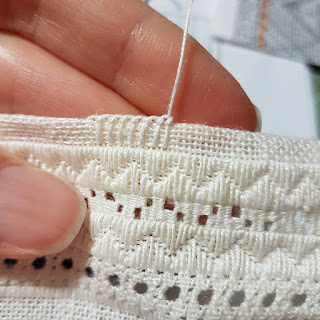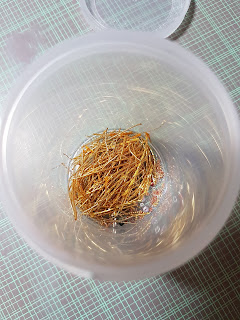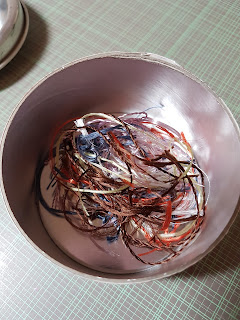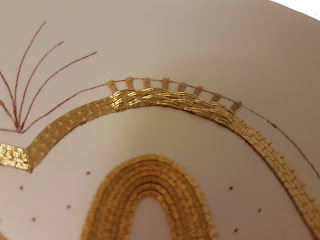Last Friday, I received the passing thread Lucy Barter was kind enough to send me. I had to be good and finish Hedebo Enchantment before I could start but I didn't waste much time once it was done. She sent me two bundles of passing, I'll have extra to play with.
No more plunging! I was really happy to reach this point. Above and below the basket-weave, I couched over stretched pearl purl.
The instructions said to only wrap the bottom one with thread, but I decided to do both as I liked the look. There was more overstretched pearl purl at the top with a piece of looped bright check. It gives it a lovely contrast.
From here on out, everything that is left is considered cutwork. This is where the metal thread is cut to size before being embroidered. The first technique is s-ing. It's basically a stem stitch with a quarter inch piece of smooth purl. I love this technique, it gives such a lovely texture and look to the piece.
This next part is what cutwork is all about. I did a tiny bit of it on my butterfly back in March and Foxy a little bit more on his tail, but nothing like this flower. I did find that as I went along it was getting easier and easier to do. I initially drew diagonal lines on the string padding to help me follow the line, but I quickly gave that up.
Usually if your string padding is the same all the way through, you can measure a piece of check or smooth pearl and just cut the rest the same size. Since mine tapered off on each end, I couldn't do that. I had to measure out every single piece. Below, you can see where I marked off my smooth pearl for cutting. To mark off the smooth pearl and bright check you just lightly press with your finger.
This area of the flower is worked alternating between smooth pearl and check. Doesn't it look pretty?
Now that I'm so near the end, I'm taking a few steps back to really look at the piece. I love the choices that Lucy made, especially where she alternates two different types of metal threads, like the Japanese and passing, and the smooth pearl and bright check. The piece really glimmers and shines because of it.
I'm almost done with the piece, I saved the best for last: chipping! I started yesterday and the felt in the center is already filled in. Tonight I will work on the left side.
First order of business was to finish my basket weave. Based on pictures I've seen of Lucy's finish there should be eight rows of passing to fully cover the arc. Some places were filled by the time I got to the sixth row, but you really need eight to fully cover the design lines.
No more plunging! I was really happy to reach this point. Above and below the basket-weave, I couched over stretched pearl purl.
The instructions said to only wrap the bottom one with thread, but I decided to do both as I liked the look. There was more overstretched pearl purl at the top with a piece of looped bright check. It gives it a lovely contrast.
From here on out, everything that is left is considered cutwork. This is where the metal thread is cut to size before being embroidered. The first technique is s-ing. It's basically a stem stitch with a quarter inch piece of smooth purl. I love this technique, it gives such a lovely texture and look to the piece.
This next part is what cutwork is all about. I did a tiny bit of it on my butterfly back in March and Foxy a little bit more on his tail, but nothing like this flower. I did find that as I went along it was getting easier and easier to do. I initially drew diagonal lines on the string padding to help me follow the line, but I quickly gave that up.
This area of the flower is worked alternating between smooth pearl and check. Doesn't it look pretty?
Now that I'm so near the end, I'm taking a few steps back to really look at the piece. I love the choices that Lucy made, especially where she alternates two different types of metal threads, like the Japanese and passing, and the smooth pearl and bright check. The piece really glimmers and shines because of it.
I'm almost done with the piece, I saved the best for last: chipping! I started yesterday and the felt in the center is already filled in. Tonight I will work on the left side.
























































